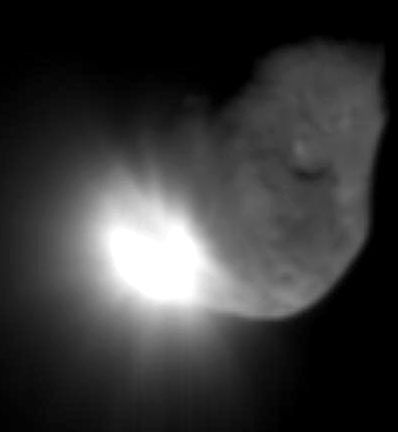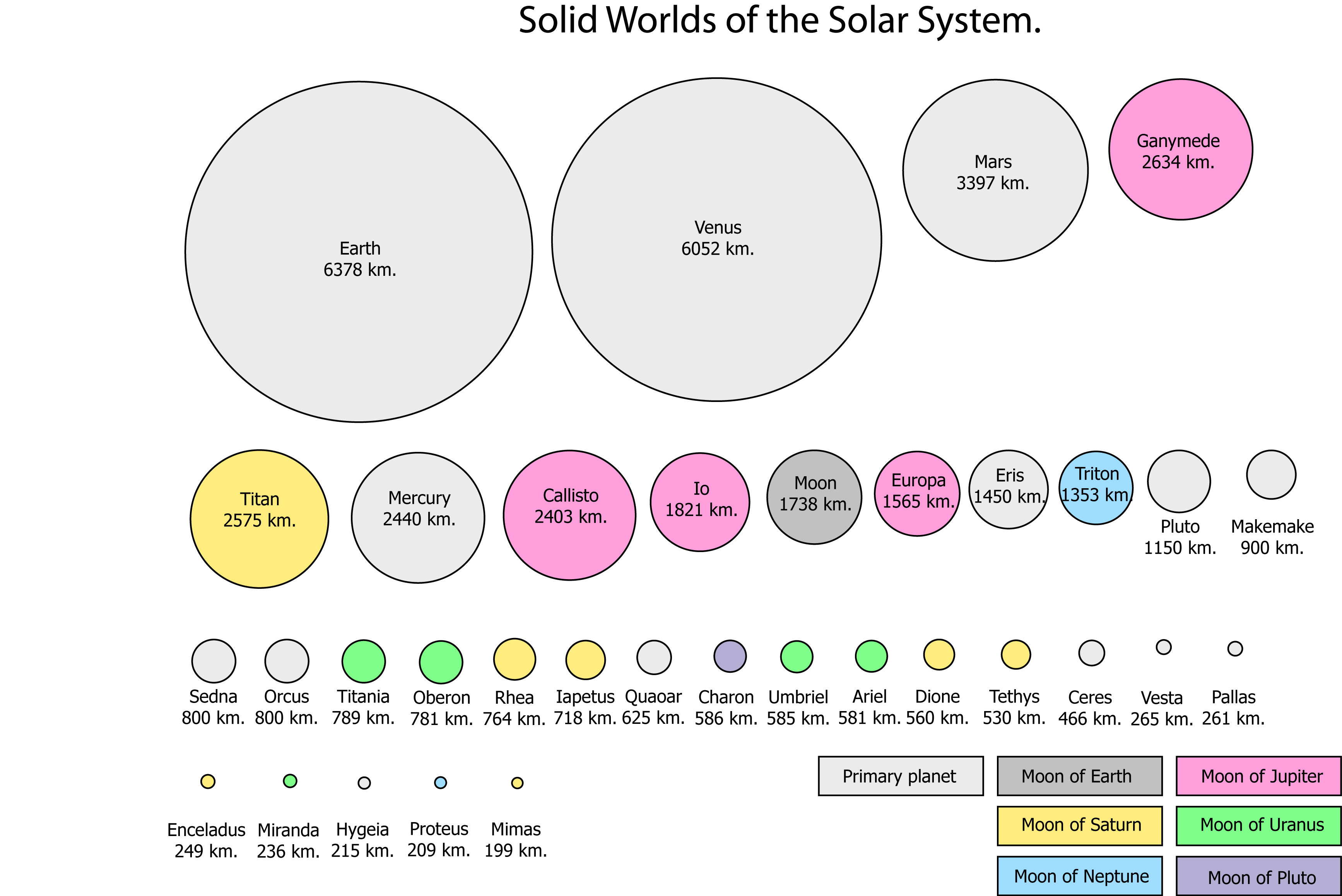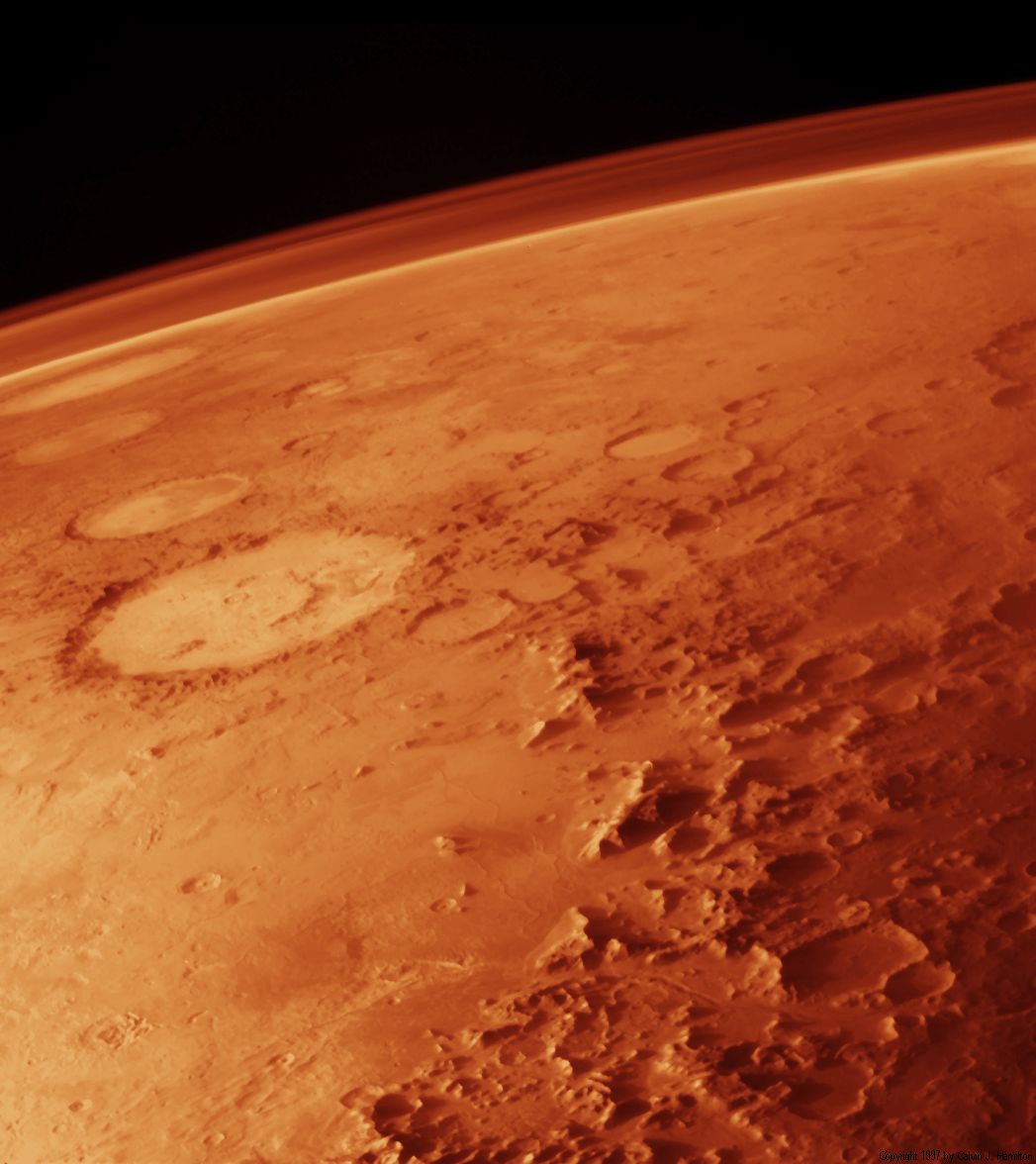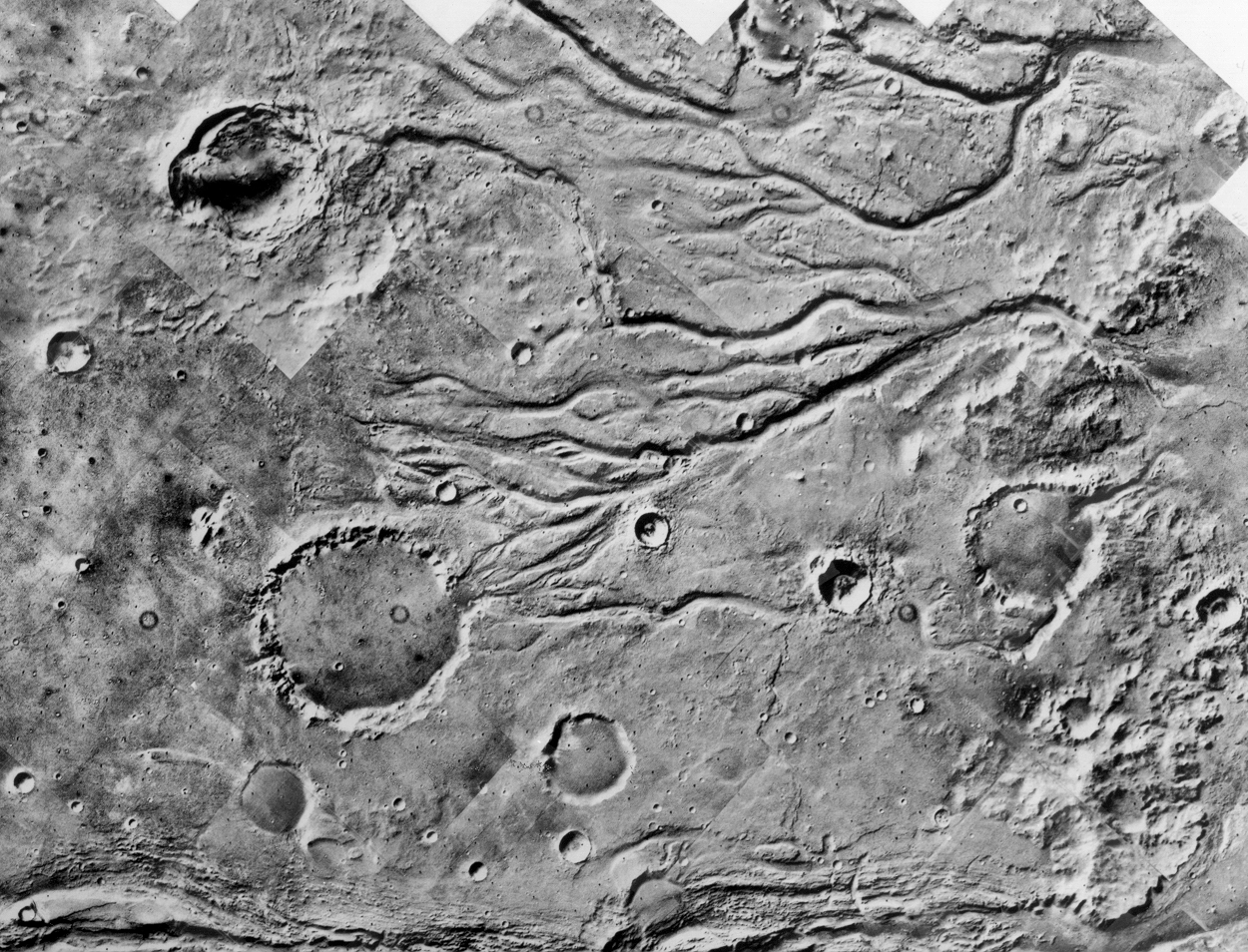 Strange climates: Earth's climates, even though they change over time, are so familiar to us that we view them as the norm, and don't even blink when TV series like Star Trek show us an unending parade of worlds that look just like Southern California (or British Columbia, if you are a BSG fan). Is this remotely reasonable? What happens to atmospheric dynamics when you tweak planetary parameters even a little bit? Our own solar system provides some clues, that this presentation seeks to iluminate. But first, some preliminaries.
Strange climates: Earth's climates, even though they change over time, are so familiar to us that we view them as the norm, and don't even blink when TV series like Star Trek show us an unending parade of worlds that look just like Southern California (or British Columbia, if you are a BSG fan). Is this remotely reasonable? What happens to atmospheric dynamics when you tweak planetary parameters even a little bit? Our own solar system provides some clues, that this presentation seeks to iluminate. But first, some preliminaries.
The "Wow" Factor: What an age of wonders we live in. When I was a child, the only way to study the planets was through a telescope. Now robot spacecraft send us in situ information, including:




Indeed, only one of the traditional nine planets - Pluto - has not ever been visited by a robot spacecraft (although the New Horizons spacecraft is due to fly past in 2015). With all of this new data to look at, it would be a very strange thing if interesting patterns didn't emerge. In fact, although every planetary body is unique, there are distinct patterns of similarity and differences.
Forget about "planets": This lecture is on the worlds of the solar system and their atmospheres. Merck's practical definition of a "world:" Any primarily solid object that exerts enough gravitational force to pull itself into a roughly spherical shape. By this criterion we can identify a world anywhere that we encounter one, regardless of what it is orbiting. Thus:
- Saturn's moon Mimas, (Diameter 260 mi.) is a world, whereas
- the slightly smaller moon Hyperion (Diameter 223 mi.) is merely a "rock." (Some workers call these "potatoes.")
- The gas giant planets Jupiter, Saturn, Uranus, and Neptune will don't really count because they are predominantly fluid.
- Venus
- Earth
- Mars
- Titan

Now, five questions:
More

It loses its atmosphere. A world's escape velocity depends on its ratio of Mass/Radius. It has nothing to do with object that does the escaping. The escape velocity is the same for a rocket or a gas molecule. So, what is the velocity of a gas molecule? It depends on the temperature and the molecular mass of the gas. Hot gas molecules move at higher velocities than cold gases, and heavy molecules move more slowly than light ones. When we compare large and small worlds of the same temperature like Earth (escape velocity=11.2 km/s) and the moon (escape velocity=2.4 km/s), it is no surprise that the moon has lost any atmosphere that it may ever have had, as molecules have been accelerated past its escape velocity.
 2. What happens when space weather interacts directly with a world's surface?
2. What happens when space weather interacts directly with a world's surface?
The The moon:
The moon has no atmosphere to speak of, although in its neighborhood, there are maybe twice as many atoms per unit volume than in vacuum of space. Nevertheless, even here there are items of interest:
- Water: Compared to Earth, the moon is dry. No bodies of water and, indeed, there is little water locked up inside rocks. And yet, a recent fleet of robot spacecraft (including NASA's LCROSS (Lunar CRater Observation and Sensing Satellite)) have found evidence of significant quantities of water ice in places of permanent shade in the crater floors of the lunar poles. Indeed, the discovery of similar ice on asteroid suggests that water may be common in shaded spots in the inner solar system.

- An enigma: The moon has no air, but Apollo astronauts claimed to see crepuscular rays - the glow of the sun illuminating something above the moon's surface at sunrise
- The solar wind: The space around the moon is not empty. The inner solar system is buffeted by a strong solar wind of charged particles. Earth's magnetic field diverts this wind around us (except at the poles where the solar wind's impact on the upper atmosphere generates auroras.) The moon, however, with no magnetic field or air to deflect the solar wind, is hit directly. This causes dust on the moon's surface to become electrically charged. Since rock is a poor conductor of electricity, dust particles accumulate enough charge to levitate electrostatically as a result of mutual repulsion.
 The moon is representative of many small rocky bodies of the solar system that lack proper atmospheres. Subsequently, ponds of regolith have been seen to accumulate in depressions on asteroids. What force moves it there? Possibly impacts, or as a result of levitation of dust from the accumulation of electrostatic charges from the solar wind.
The moon is representative of many small rocky bodies of the solar system that lack proper atmospheres. Subsequently, ponds of regolith have been seen to accumulate in depressions on asteroids. What force moves it there? Possibly impacts, or as a result of levitation of dust from the accumulation of electrostatic charges from the solar wind.
More
3. What happens when space weather interacts directly with a world's atmosphere?
Consider Mars.
 Mars has a proper permanent (?) atmosphere. This atmosphere is mostly CO2, but is thin. At 6.3 x 10-3 bars, it is roughly 1/100th the thickness of Earth's.
Mars has a proper permanent (?) atmosphere. This atmosphere is mostly CO2, but is thin. At 6.3 x 10-3 bars, it is roughly 1/100th the thickness of Earth's.
- Its butterscotch color mostly comes from tiny dust grains suspended in it. Without this dust, Mars' sky would look black.
- The only time optical scattering of sunlight colors the sky is at sunset, when sunlight passes through enough air to produce blue sunsets.
- Although thin, Mars' atmosphere supports active weather, including dust-devils and global dust storms, and shows seasonal changes.
- At high latitudes, water-ice clouds can be seen.
But now the problem: There is evidence that Mars once had a much more substantial atmosphere. Where has it gone?

- Some maintain that Mars was once covered with extensive oceans.
- Features that look like ancient deltas certainly argue for this.
- Mars is definitely the only terrestrial planet beside Earth on which the transport of sediment by water has ever been a major source of remodeling. Some evidence suggests that small scale streams may occasionally flow on Mars today.
- The recent discovery of large amounts of hydrogen peroxide (H2O2) in Martian soils points to an interesting possibility: That Martian groundwater is actually a mild hydrogen peroxide solution with a much lower freezing point than distilled water.
 Adding color to these observations are those made by by the rover Opportunity.
Adding color to these observations are those made by by the rover Opportunity.
- Cross beds! (arrow) These indicate ancient current flow.
- Countless small concretions, termed "blueberries." concretions that precipitate in groundwater. The rovers have sampled extensive outcrops, such as those in the walls of Endurance Crater.
- One mineral that is common - jarosite forms on Earth only in the presence of highly acidic water. Mars' ancient water may have had a pH as low as 2. Ouch.
Does water still flow? Possibly. We know that on Mars, the wind actively moves sediments. Indeed, the Mars rovers have witnessed dust devils and constantly have to avoid dunes. From orbit, however, we have seen small water-deposited features like alluvial fans superposed over dunes. These can't be terribly old.

So, the water in Mars' atmosphere, at least, seems mostly to have frozen.
But this begs the bigger question: Why did Mars once have rivers and now have, at most, tiny ephemeral flows of groundwater?
 Mars is a small world (escape velocity 5.0 km/s). Thus, even though it is colder than Earth, we expect its atmosphere to leak into space faster. That wouldn't be a problem if its atmosphere were being replenished by gasses from volcanic eruptions.
Mars is a small world (escape velocity 5.0 km/s). Thus, even though it is colder than Earth, we expect its atmosphere to leak into space faster. That wouldn't be a problem if its atmosphere were being replenished by gasses from volcanic eruptions.
During its first two billion years, Mars was volcanically very active. Even now, it boasts the largest volcanoes in the Solar System. Whether these volcanoes ever so much as burp today is a pressing question, but in all probability, we have missed seeing major volcanic activity there by over half a billion years. So, it looks like Mars' atmosphere is not being replenished.
 But simple leakage is not Mars' only problem. Mars is close enough to the Sun to experience a strong solar wind. Does Mars have a global magnetic field like Earth's to deflect it? At one time it may have. Recent measurements of weak remnant magnetism preserved in its rocks reveal a pattern of geomagnetic reversals like those of Earth. The problem, is that these are only evident in rocks that are over 2.5 billion years old. Maybe in its early history (the same age as its wet surface) Mars' atmosphere was protected from the solar wind. For most of its history, however, it has not been, so that the solar wind has slowly stripped gasses from its upper reaches. In short, Mars is a world that is losing its atmosphere.
But simple leakage is not Mars' only problem. Mars is close enough to the Sun to experience a strong solar wind. Does Mars have a global magnetic field like Earth's to deflect it? At one time it may have. Recent measurements of weak remnant magnetism preserved in its rocks reveal a pattern of geomagnetic reversals like those of Earth. The problem, is that these are only evident in rocks that are over 2.5 billion years old. Maybe in its early history (the same age as its wet surface) Mars' atmosphere was protected from the solar wind. For most of its history, however, it has not been, so that the solar wind has slowly stripped gasses from its upper reaches. In short, Mars is a world that is losing its atmosphere.
More
 4. What would Earth's atmosphere look like if there were no oceans?
4. What would Earth's atmosphere look like if there were no oceans?
In a word, it would look like Venus
They call Venus Earth's "evil twin." Barely smaller than Earth, it's geologic features are similar to what we see here. Because it's size, internal heat, and gravity are similar to Earth's, its crust is tectonically active:
- It has many volcanoes
- Its surface has distinct continent-like regions of high elevation and extensive ocean-floor like low plains. Unlike Earth, however, it has lots of regions of intermediate elevation - a relative rarity on Earth.
- Venus has features that might be vaguely analgous to sea-floor spreading zones, like the rifts of Beta Regio.
- But it absolutely lacks anything resembling trenches and subduction zones.
 So Venus' geology is slightly different from earth's, but its surface conditions are radically different. To understand why requires some background.
So Venus' geology is slightly different from earth's, but its surface conditions are radically different. To understand why requires some background.
Effective temperature: The ideal temperature at which a planet precisely re-radiates all of the energy it receives from the sun.
Te4 = L / (4πR2 x 5.67 x 10-8)
Where:
- L = actual power radiated (balanced with incoming solar radiation)
Effective temperature is thus a function of:
- Incoming solar radiation
- The planet's surface area
Albedo: However, to know incoming solar radiation, we must also consider Albedo, the amount of radiation reflected back into space. Clouds and surface features like ice caps have high albedo. Likewise:
- Reflective icy worlds like Enceladus have high albedo.
- Dark worlds like Mercury have low albedo.
- Iapetus (a moon of Saturn, right) offers a contrast of high and low albedo.
Albedo is measured on a scale from 0.0 (no reflectivity) to 1.0 (all light reflected). Modest examples:
- Mercury - 0.10
- Venus - 0.77
- Earth - 0.30
- Mars - 0.25
Incorporating albedo into estimates of effective temperature, we get:
- Venus: 227 K
- Earth: 255 K
- Mars: 217 K
- Earth: 288 K
- Venus: 733 K (!)
WTF?
Earth is 33 K warmer than expected. Venus is 500 K warmer. This difference is because of the greenhouse effect - the ability of planetary atmospheres to trap heat. Solar energy usually reaches planet's surface in the form of visible light. Whatever fraction is not reflected by albedo heats whatever opaque surface absorbs it. In the case of Venus, the atmosphere is very dense and mostly made of a greenhouse gas.
Venus, unlike Earth, has essentially no carbon cycle. On Earth,
- Carbon enters the atmosphere as CO2 that erupts from volcanoes.
- Atmospheric CO2 dissolves in oceans.
- Eventually CO2 precipitates out of solution as carbonate minerals that become incoporated in the rocks rocks.
- As they become buried deeply, they can melt, releasing carbon that, again, is erupted into atmosphere as CO2.
Follow this link for a fictional but realistic cinematic imagining of Venus' surface. BBC's Voyage to the Planets - Venus. But on Venus there is no hydrosphere, so CO2 just gathers in the atmosphere.
But wait! Venus is closer to the Sun than Earth. Why does the solar wind not strip away its atmosphere like it does that of Mars? Apparently it does. The near absence of water vapor is attributed to the dissociation of H2O by ultraviolet radiation and the subsequent removal of hydrogen by the solar wind. The difference between Venus and Mars is that while Mars is geologically dead (mostly), Venus continues to pump gasses out of volcanoes. Thus, its atmosphere continues to grow as long as its volcanoes continue to erupt.
Icing: Did I mention that the clouds are made of droplets of sulfuric acid?
 5. Could other substances mimic Earth's atmosphere?
5. Could other substances mimic Earth's atmosphere?
Sort of. Consider Saturn's cold moon Titan
Physical specs:
- Radius: 2575 km (compared with 1738 for the Moon)
- Density: 1.88 x 103 kg m-3 (compared with 3.34 for the Moon)
- A hydrologic cycle based on liquid methane and ethane, including evaporation, rainfall, runoff, and accumulation in liquid bodies the size of the great lakes.
- Cryovolcanoes
- Vast "seas" of dunes. What are they made of? Some unfamiliar hydrocarbon compound similar in consistency to coffee grounds.
- The occasional impact crater. Their rarity leads us to think that Titan is actively geologically resurfacing itself. For fun, watch two of
 Titan's idiosyncrasies:
Titan's idiosyncrasies:
- Seasonal "rainy" and "dry" seasons: Titan orbits in Saturn's equatorial plane, which is slightly inclined to the ecliptic. Thus, Titan experiences seasons during its (and Saturn's) 30 year "year." Atmospheric models predict that bodies of liquid methane/ethane will be more common near the winter pole. Confirming this, most of the lakes found so far have been in the northern high latitudes - the winter hemisphere.
- Rainfall in the mid-latitudes is expected to be vanishingly rare, but torrential when it occurs. During 2010, a storm front was observed in Titan's equatorial region. See also this link.
- Greenhouse effect vs. anti-greenhouse effect: Titan has a greenhouse effect caused by absorption of infrared by cold N2, H2,and CH4 (methane). (At higher temperatures N2 and H2 are transparent to infrared.) Some numbers:
- Titan's effective temperature: 82 K
- Titan's modeled temperature with greenhouse effect: 105 K
- Titan's observed mean surface temperature: 93.7 K
Remember that visible light images of Titan show a featureless orange smog atmosphere. Images showing surface features are in infrared. Thus, infrared wavelengths penetrate Titan's atmosphere and visible ones don't. This results in an anti-greenhouse effect that takes away about half of the heat retained by the greenhouse effect.
Besides Earth, Titan is the only world in the solar system known to have an active hydrologic cycle. Thus, it is strangely similar to Earth and strangely different.
- Methane and ethane don't behave like water chemically. Thus Titan has some very exotic chemistry that has yielded widespread substances (like whatever makes up its dunes) with no earthly analog.
- Liquid methane and ethane don't behave physically like water, either. For example, although we can see sunlight reflected off its smooth surface, we see no evidence whatever of waves, even though we know that wind blows over it. Is it viscous like molasses?
Titan paradox: But wait! Titan does not have a magnetic field. Why does it have an atmosphere 1.5 times as dense as Earth's while Mars' is only 0.01? Answers:
- Titan is far enough from the sun that the solar wind is extremely thin.
- Titan orbits inside Saturn's magnetic field.
- But the big reason: Titan is so cold that gas molecules seldom move fast enough to achieve escape velocity. Jupiter's similar-sized moon Ganymede, while cold, at -260 F., is slightly warmer and airless.
More
 A final note: Don't cry for the astronomers because they own the last big breakthrough of the decade:
A final note: Don't cry for the astronomers because they own the last big breakthrough of the decade:
By observing the perturbations in the motion of stars caused by the gravity of orbiting planets, the presence of up to two hundred planets outside the solar system - Extrasolar planets has been inferred.
Some of the known exoplanets have interesting weather. Consider:
- Corot 7b (right), a rocky world five times Earth's mass circling a mere 1.6 million miles from its star. On it, many silicate materials that form our rocks are thought to evaporate, such that a cold front would be accompanied by a rain of pebbles into a globe girdling magma sea.
We await the discovery, in our lifetimes, of more Earthlike planets with more normal weather.
